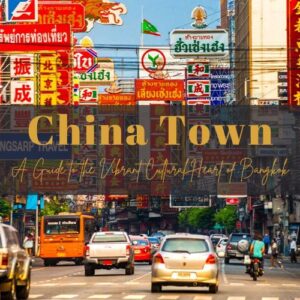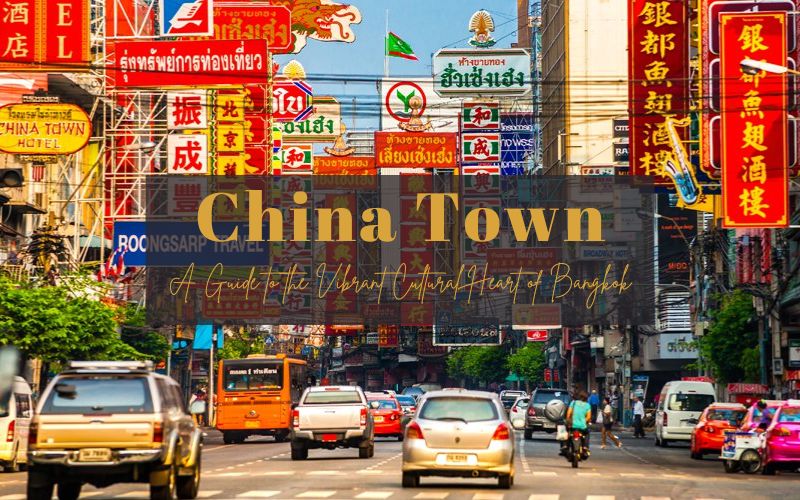
China Town is a must-see destination for any visitor to Bangkok, offering a vivid and authentic look at Bangkok’s cultural diversity. Bangkok’s Chinatown is a fascinating blend of history, culture, and cuisine, inviting visitors to immerse themselves in its vibrant mosaic.
Overview of Chinatown
Chinatown, also known by its Thai name Yaowarat, is located in Samphanthawong district, in the heart of Bangkok. It is one of the largest Chinatowns in the world. China Town is an important piece that creates diversity in the culture of the community of Thai people. This place is definitely an ideal destination you cannot miss on your trip to Thailand.
About 300 years ago, Chinese merchants followed the Silk Road to exchange and trade goods with the Siamese (also known as the Thai people today). Gradually, business activities expanded and developed, so they decided to stay and establish a bustling, prosperous, and crowded China Town, selling a variety of goods, from clothes, souvenirs, spare parts for machinery and equipment, electronics, antiques, imported goods… and especially food and drinks.
Ready to explore Thailand’s treasures? Dive into this 10-Day Discovery Tour and uncover everything from ancient temples to vibrant floating markets.
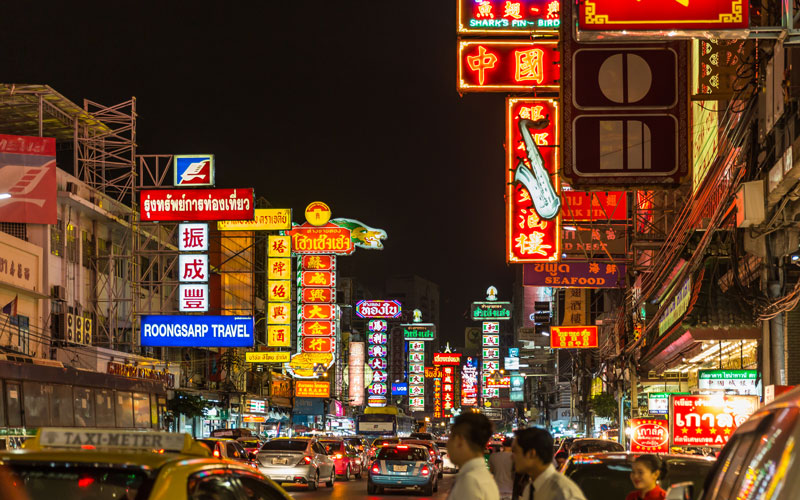
China Town at night
Key Attractions at Chinatown
Sampeng Market
Address: Soi Wanit 1, Yaowarat, Bangkok
Opening hours: 8 AM to 6 PM
Sampeng Market, located in Bangkok’s Chinatown, is one of the city’s busiest and most vibrant local markets. It is a must-visit for visitors who enjoy local-style shopping. It is a particularly good place to buy wholesale or bulk items, so it is a good choice when shopping for souvenirs and gifts. At Sampeng Market, you can find clothing and fabrics, jewelry, household items, electronics, food, children’s toys, and more. As one of Bangkok’s most popular markets, it is often crowded, but that makes it all the more interesting.
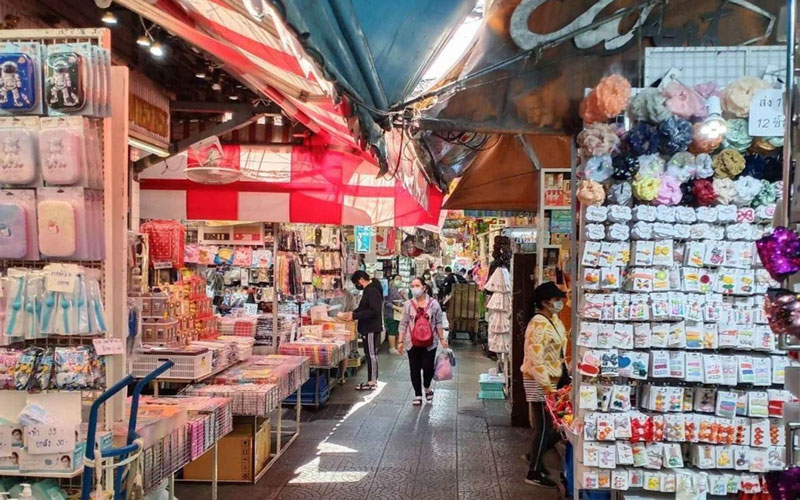
Sampeng Market
Little India
Address: Phahuray Road, Phra Nakhon, Bangkok
Opening hours: 9 AM to 6 PM
Little India is also known as “Phahurat Market”. The street is located not far from the Chao Phraya River. Coming here, you can enjoy some authentic Indian street food such as curry, rice, … In addition, you can visit the Sikh temple with a golden dome that impresses visitors at first sight. There are many items here such as colorful and meticulously patterned costumes, jewelry, handicrafts, …
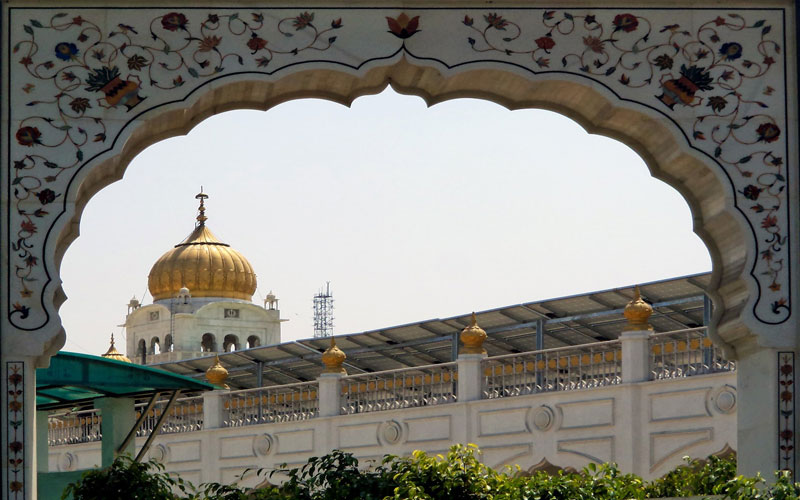
Sikh temple in Bangkok
Yaowarat Night Market
Address: Yaowarat Street, Bangkok
Opening hours: 6 PM – late night
This is one of Bangkok’s biggest and most famous night markets. after sunset, the market becomes bustling with street food stalls, restaurants and live music. you can find everything here from clothes, accessories, souvenirs to delicious street food. There are also street art performances or fun games.
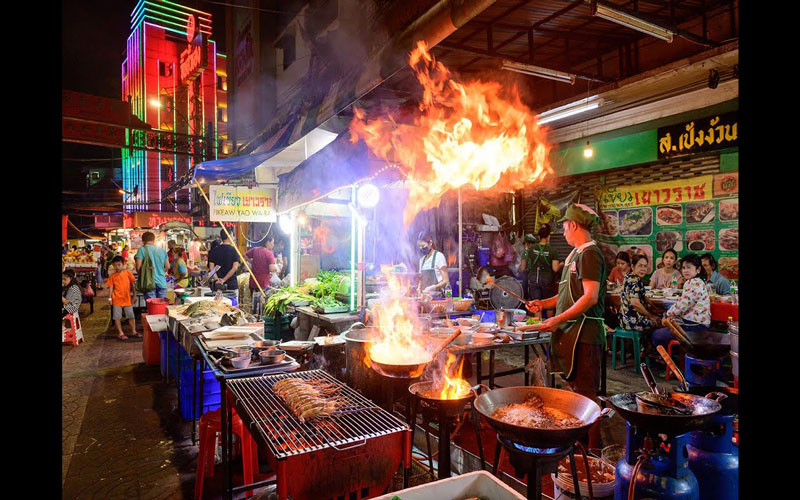
Street food at Yaowarat night market
Wat Mangkon Kamalawat
Address: Phra Nakhon, Bangkok
Opening hours: 9 AM to 5 PM
Free entrance fee
Wat Mangkon Kamalawat is the largest and most significant Chinese Buddhist temple in Bangkok. It was built in the late 19th century and is a popular tourist destination for those who want to learn more about Buddhism and Thai history. Wat Mangkon Kamalawat is beautifully decorated with unique and exquisite artwork, including statues representing deities and wall paintings. The temple also hosts many festivals and special events throughout the year. One of the most famous is the Songkran festival in April, attracting locals and tourists with lots of fun activities, live music and delicious food.
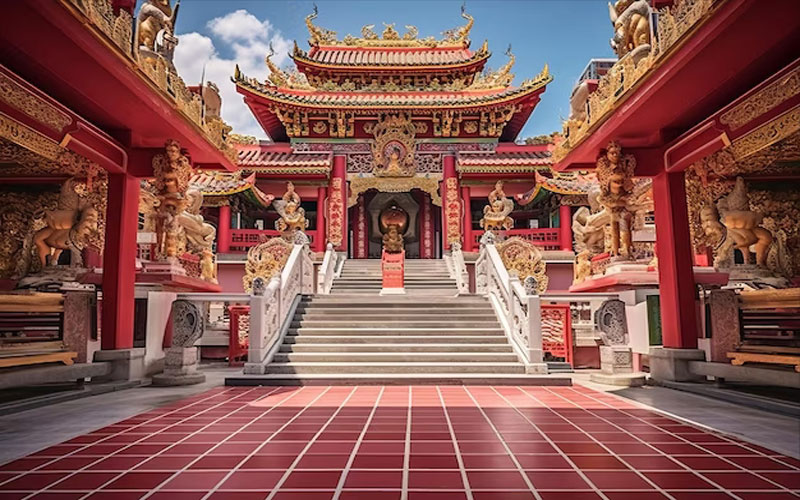
Wat Mangkon Kamalawat
Wat Traimit
Address: Yaowarat Street, Samphanthawong, Bangkok
Opening hours: 8 AM to 5 PM
Entrance fee: 100 Baht per person
The highlight of this temple is the world’s largest golden Buddha statue, 3 meters high and weighing more than 5 tons. For centuries, this statue was covered with a thick layer of plaster to hide its true value. Until the statue fell and broke during transportation, revealing the real gold layer inside, making it a symbol of worship and important in Thailand culture. The entire temple is also decorated with 24K gold, creating brilliant and sacred architecture. People and tourists come here to pray for luck, health and find peace in life.
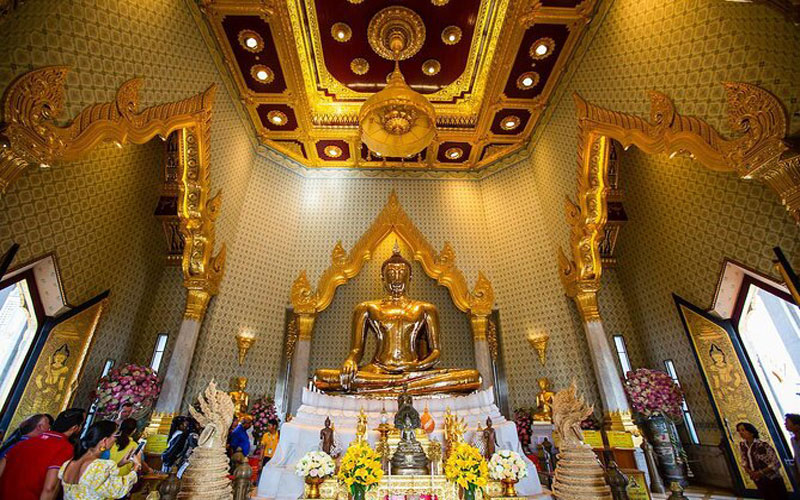
the golden Buddha statue in Wat Traimit
China Gate
This is the symbol of Chinatown and a popular photo spot for tourists. It was built in 1999 to celebrate the 60th birthday of King Rama IX. China Gate is designed in Chinese architectural style with 2 winding dragons on both sides and elaborate patterns.
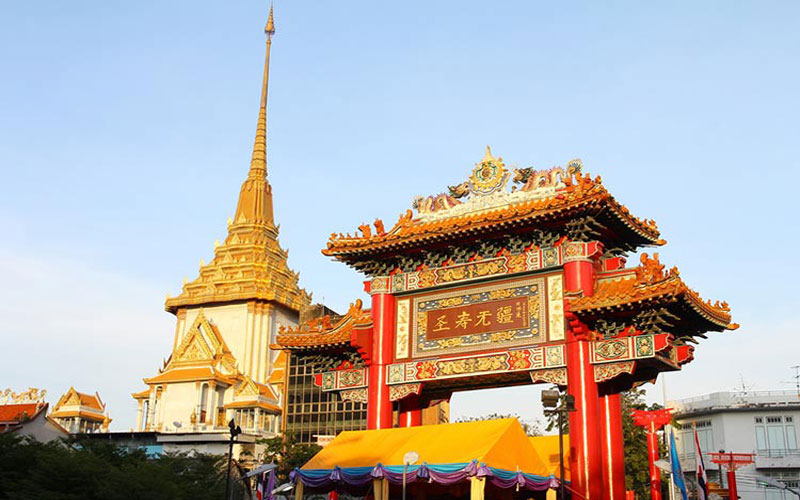
China Gate
Samphanthawong Museum
Address: Samphanthawong District, Bangkok Chinatown
Opening Hours: 09:00 – 17:00
Free entrance fee
Samphanthawong Museum is the first cultural museum dedicated to the Chinese community in Thailand. This is a must-visit destination if you are interested in the history and life of the community here. The museum offers visitors an in-depth journey into the history and contributions of the first Chinese immigrants in the area.
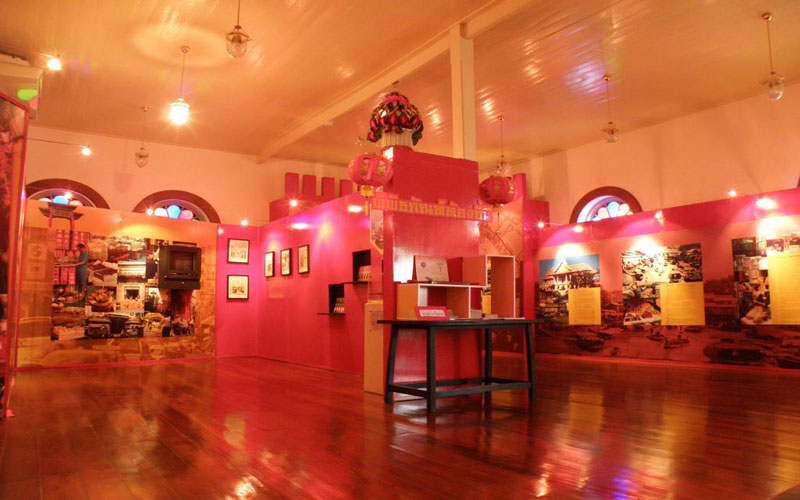
Samphanthawong Museum
What to Eat at Chinatown
Yen Ta Fo (Seafood Noodle Soup)
Yen Ta Fo is notable for its pink soup, which is the result of the addition of fermented soybean paste. It is often served with a mix of seafood, water spinach and deep-fried tofu. The soup is both sour and slightly sweet, giving it a completely unique flavor. You can enjoy this dish at Yen Ta Fo Wat Khaek.
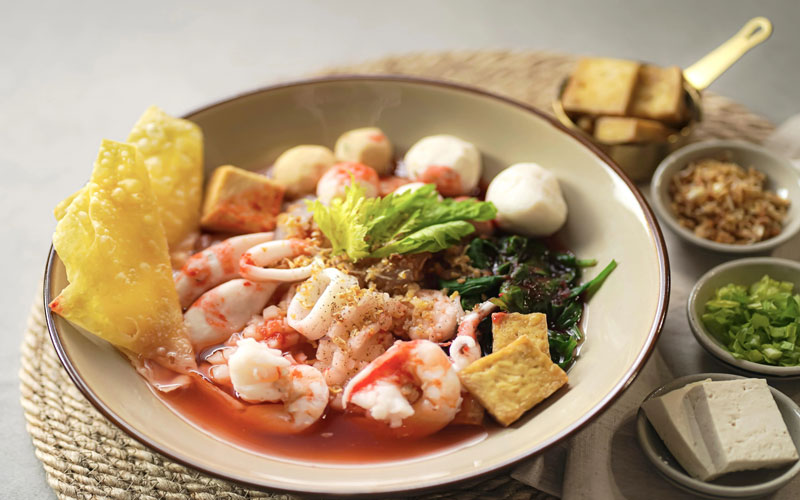
Yen Ta Fo
Dim Sum
For snackers, dim sum in Chinatown is a must-try. This dish ranges from steamed buns and dumplings to more strange options like chicken feet and pork ribs. Hua Seng Hong is particularly famous for its fresh dim sum, which can be enjoyed at any time of the day.
Guay Jub (Rolled Rice Noodle)
Guay Jub (or Kway Chap) is a spicy Thai-Chinese noodle soup made with pork belly, pork intestines and large, flat rice noodles rolled in a clear, spicy broth. It is a signature dish of Chinatown. There are two MICHELIN-recognized Guay Jub stalls on Yaowarat Road: Guay Jub Ouan Pochana and Nai Ek Roll Noodles.
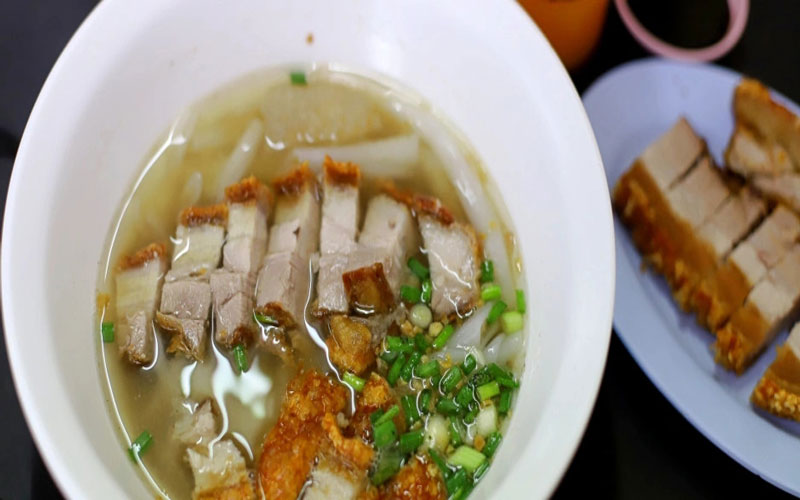
Guay Jub
Mango sticky rice
While mango sticky rice can be found all over Bangkok, China Town has some of the best, thanks to the perfectly ripe mangoes and the right amount of stickiness of the rice. Drizzled with sweet, creamy coconut milk, this dessert is a refreshing end to any meal.
Pa Tong Go
Pa Tong Go is a snack similar to a Chinese doughnut or a Spanish doughnut but with a different shape and less sweet taste. It is a favorite breakfast food among Thais and Chinese in Bangkok. Most people order it crispy and deep-fried, or you can try it grilled, then dipped in a variety of toppings such as pandan coconut sauce or condensed milk. The Pa Tong Go Savoey stall in Chinatown Bangkok was listed on the Michelin food map in 2018 and 2019.
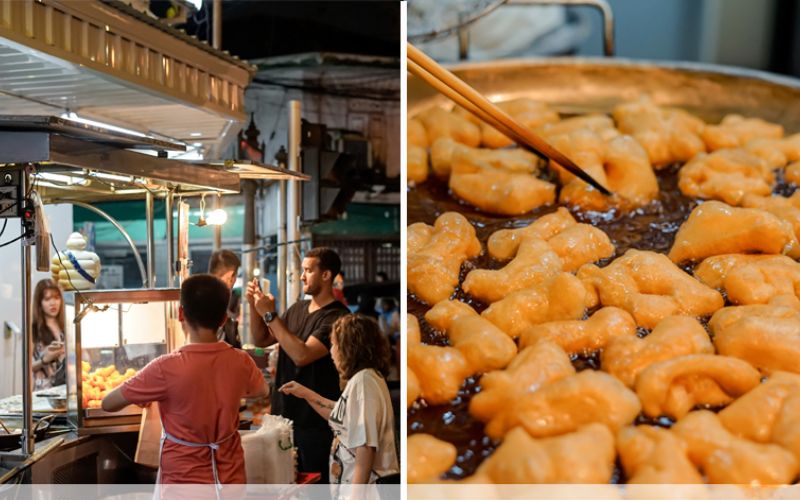
Pa Tong Go Savoey
How to Get to Chinatown
There are several ways to get to China Town, depending on your preferences and budgets.
BTS/MRT
This is a means of transportation to China Town with a reasonable price and very convenient and you can also avoid traffic jams. Currently, there is no MRT or BTS line going through so you need to take the train to Hua Lamphong station, then walk to Yaowarat Road.
Grab
Grab is always a great choice when traveling in any country. The plus point of Grab is its convenience, the way to use it is extremely simple and the service is always available 24/7 so you don’t have to worry about being late or not being able to catch a car. However, the cost of traveling by Grab is quite high, but if you travel in a large group, this is definitely the perfect and most economical choice.
Tuk tuk
Tuk tuk is a three-wheeled vehicle with a dome but no doors, allowing visitors to comfortably enjoy the weather and visit the city. This is a typical form of transportation in Thai culture, helping you to take the initiative in your schedule as well as have more experiences closer to the lives of local people. When choosing to take a tuktuk, you should negotiate and haggle the price carefully before getting on the vehicle.
Public bus
This is considered the cheapest way to travel anywhere in the city, only about 24 – 35 Baht/trip depending on the specific distance. However, buses can take a long time to wait and travel and can be very crowded during rush hour, so you need to consider your schedule.

BTS Skytrain
Tips for your Trip to Chinatown
Here are some tips for you to have a memorable and enjoyable experience in Bangkok’s Chinatown:
- Chinatown really comes alive at night when the bustling streets and neon lights illuminate the area. So come here in the evening to experience the best vibrant atmosphere, shop and enjoy local food.
- Wear comfortable shoes because the streets in Chinatown are often narrow and crowded, and you may have to walk a lot to get around.
- If you visit in late January or early February, try to take part in the Lunar New Year festival. The streets will come alive with lion dances, dragon parades and vibrant performances, making this one of the best times to experience Chinatown culture.
- Although most places accept payment by bank transfer or visa card, you should carry some cash with you because street vendors or small street stalls only accept cash payments.
- Bargain is common in Chinatown markets, but always be polite and smile when talking to vendors. They are often willing to bargain, especially on items like clothing, accessories and souvenirs.
- Chinatown can be very crowded, especially in the evenings and during festivals. Keep your belongings safe and beware of pickpockets in crowded areas.
Embark on a journey through Southeast Asia’s rich cultural tapestry. Discover the stunning Heritages of Vietnam, Laos, and Thailand in 15 days, where ancient traditions, breathtaking landscapes, and vibrant cities come together for an unforgettable adventure.
Bangkok’s Chinatown offers an unforgettable blend of vibrant street life, rich cultural heritage and delicious cuisine. Coming here visitors can experience the fusion of Thai and Chinese cultures unlike anywhere else in the city. Whether you visit at any time, Chinatown is sure to offer you an unforgettable trip to Thailand.

